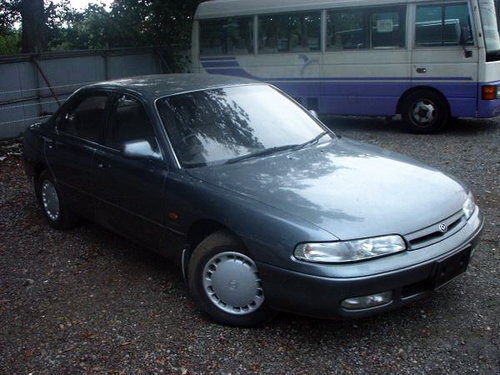Mazda Cronos GE, 1 generation, restyling 10.1994 - 12.1995

(GE)
10.1994 - 12.1995
E-GE5P, E-GEEP, E-GESR, X-GEEP, Y-GEFP
1 generation, restyling
Choose parts group:
Sedan
The car made its debut in October 1991, it was a middle-class sedan, which replaced the Capella sedan. It is a relative of the MS-6 models (Efini trading house) and Autozam Clef (Autozam trading house). The name of the car comes from the god of time in ancient Greek mythology.
The car was part of the class of 2-liter sedans, but was produced with a body of the 3rd dimensional group, the width of which was as much as 1770 mm. Just as it was thought at that time, a middle class sedan should look.
A new 6-cylinder engine with a volume of 2 or 1.8 liters, which was located in front, stood across the chassis, and the cylinders were divorced by 60 degrees. The engine was highly praised, it was even said that it was quite comparable to the motor installed on the European Alfa Romeo model. The all-wheel drive version, however, was equipped with a different kind of engine - a 4-cylinder in-line engine, DOHC. Suspension of the rear wheels - on double wishbones, the axes of the upper and lower levers did not coincide, which made it possible to provide the desired angle of convergence of the wheels.
In March 1992, a P.W.S. The P.W.S. system, which was tested on the Capella model and sometimes denoted by the phrase “pressure wave supercharger”, allowed the engine to instantly and smoothly respond to any, even a sharp press of the accelerator pedal. In May of the same, 1992, a Grand Turismo category car was launched. This machine was equipped with an engine that developed power up to 200 horsepower, and shock absorbers with built-in springs, as well as anti-roll bars of increased cross section, were used in the front suspension design. This significantly affected the behavior of the car on the go. But like related car sedans, this model did not sell well, which forced Mazda to withdraw it from production in 1994.
The car was part of the class of 2-liter sedans, but was produced with a body of the 3rd dimensional group, the width of which was as much as 1770 mm. Just as it was thought at that time, a middle class sedan should look.
A new 6-cylinder engine with a volume of 2 or 1.8 liters, which was located in front, stood across the chassis, and the cylinders were divorced by 60 degrees. The engine was highly praised, it was even said that it was quite comparable to the motor installed on the European Alfa Romeo model. The all-wheel drive version, however, was equipped with a different kind of engine - a 4-cylinder in-line engine, DOHC. Suspension of the rear wheels - on double wishbones, the axes of the upper and lower levers did not coincide, which made it possible to provide the desired angle of convergence of the wheels.
In March 1992, a P.W.S. The P.W.S. system, which was tested on the Capella model and sometimes denoted by the phrase “pressure wave supercharger”, allowed the engine to instantly and smoothly respond to any, even a sharp press of the accelerator pedal. In May of the same, 1992, a Grand Turismo category car was launched. This machine was equipped with an engine that developed power up to 200 horsepower, and shock absorbers with built-in springs, as well as anti-roll bars of increased cross section, were used in the front suspension design. This significantly affected the behavior of the car on the go. But like related car sedans, this model did not sell well, which forced Mazda to withdraw it from production in 1994.




